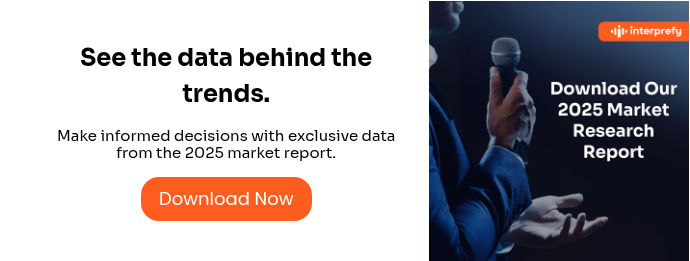Across the Middle East and Asia–Pacific, event organisers are experiencing a surge in demand for multilingual support. Interprefy’s latest market research reveals that 86 percent of event organisers in the Middle East and 71 percent in APAC already face high demand for multilingual delivery, driven by diverse audiences and cross‑border participation. This demand is matched by enthusiasm for emerging technologies: 100 percent of Middle Eastern organisers and 81 percent in APAC say they are likely or very likely to adopt remote simultaneous interpretation (RSI), AI‑generated live text captioning or AI‑powered speech translation. These statistics underline a shift from multilingual capability being a value‑added service to it becoming an essential requirement, particularly as governments across both regions tighten accessibility mandates and global investors call for equitable access to information.
While the appetite for multilingual support is strong, the regulatory landscape governing accessibility is evolving rapidly. Governments and regional bodies are introducing or enforcing laws that compel public and private organisations to make their digital communications accessible. For multilingual events — whether virtual, hybrid or in‑person — these regulations have significant implications for how information is delivered, interpreted and recorded. In this guide we unpack the most relevant mandates affecting event organisers in 2025, examine what they mean for event design and technology adoption, and offer practical insights for preparing for 2026 and beyond.
Understanding accessibility mandates in 2025
From regional laws to global expectations
When designing multilingual events for 2025, organisers can no longer think of accessibility as a collection of local rules to tick off. The biggest compliance driver is not any single statute but the way global standards now underpin legislation across regions. The Web Content Accessibility Guidelines (WCAG), created by the World Wide Web Consortium (W3C), have become the common benchmark. In October 2025 WCAG 2.2 was formally recognised as an international standard, which underscores its status as a global yardstick for digital accessibility. Since the guidelines were first published in 2008, W3C notes that they’ve been adopted by many governments and organisations, so their principles — ensuring content is perceivable, operable, understandable and robust — now underpin laws from Europe to North America, the Asia–Pacific and the Middle East. Rather than memorising a patchwork of national statutes, organisers can base their plans on WCAG and layer local requirements on top.
The global reach of the European Accessibility Act
One example of how national legislation sets de facto global standards is the European Accessibility Act (EAA). The EAA is an EU directive, but its scope covers any company selling products or services to consumers in the EU, regardless of where that company is based. From 28 June 2025, firms delivering digital services — including event registration platforms, live-streaming interfaces and payment systems — have been prompting to ensure that these services are accessible to people with disabilities. This includes making platforms and live streams compatible with screen readers and providing real‑time captions and sign‑language interpretation. The penalties for non‑compliance are steep, ranging from fines to restrictions on market access. Because APAC and Middle Eastern organisers often serve European participants or investors, the EAA has effectively become a global reference point. Meeting its requirements is not just about entering the EU market; it signals to clients and regulators worldwide that your organisation values inclusivity.
Related Article:
Is Your Company EAA-Ready? How to Make Multilingual Events Compliant
Convergence between EAA and ADA Title II
The United States is also tightening digital accessibility rules. In April 2024 the U.S. Department of Justice finalised a rule under Title II of the Americans with Disabilities Act (ADA) requiring state and local governments to ensure their web content and mobile apps meet specific accessibility standards. Though this rule applies to public entities, private organisations often follow its guidelines to manage risk. CAST, an educational research organisation, notes that the updated ADA rule and the EAA share common goals: both aim to harmonise accessibility standards and eliminate barriers for individuals with disabilities. The rule mandates compliance with WCAG 2.1 AA guidelines, the same technical baseline referenced by the EAA. This alignment underscores how regional laws are converging around shared principles. For event organisers, the takeaway is clear: design once to meet the strictest global standard, then adapt as needed for local enforcement.
Beyond borders: the UN Convention and regional frameworks
Above national laws sits a human‑rights framework that is driving policy change. The United Nations Convention on the Rights of Persons with Disabilities obliges countries to provide accessible information and communications technologies, and articles 9 and 21 specifically address web accessibility and the right to information. Many national laws derive their authority from this convention, creating a moral and legal impetus for organisations to provide inclusive communications. Similarly, regional frameworks such as the ASEAN Enabling Masterplan 2025 call on member states to mainstream disability rights and include accessible digital practices among their 76 action points. These documents do not carry direct penalties, but they shape the legislative agenda across Asia–Pacific and the Middle East have inspired the adoption of accessibility guidelines in multiple countries in the area.
Why global compliance matters for APAC and Middle Eastern events
For multilingual events, the globalisation of accessibility mandates has two major implications. First, audiences are international. An investor briefing streamed from Singapore might attract participants from Frankfurt, Dubai and Toronto. Each participant expects an accessible experience consistent with the strictest standard they are familiar with. Delivering lower‑quality captions or inaccessible interfaces risks alienating audiences and undermines the credibility of the host organisation. Second, regulators and clients look for leading indicators of compliance. Adhering to WCAG 2.2 and EAA requirements demonstrates diligence, reduces legal exposure and positions companies as inclusive partners.
What accessibility mandates mean for event design
Inclusive digital experiences are mandatory
The laws and guidelines outlined above all point to the same conclusion: accessibility is no longer optional. For event organisers, it’s not just the static pages that must meet accessibility standards; the live experience itself has to be inclusive. Legislation such as the European Accessibility Act and similar global frameworks specify that audiovisual services must provide interpretation and sign‑language interpretation, captions and subtitles in every multilingual interaction. In practice, an investor joining an earnings call from Riyadh should be able to follow the discussion in Arabic through high‑quality simultaneous interpretation while also having the option to view live captions or subtitles. This requires event platforms to embed multilingual audio channels, real‑time captioning and user‑controlled display options so that every participant receives the same information at the same moment, regardless of language or hearing ability
Simultaneous multilingual delivery is about fairness and compliance
Because accessibility is inseparable from multilingual communication, information must be provided simultaneously to all users, including those who rely on sign‑language or captions. For multilingual events, this means synchronising interpretation and captioning across all languages so that participants receive material at the same moment, regardless of the language channel they use. It is not enough to post a recording with subtitles later; both, global and local regulatory principles, require full, complete and error‑free disclosure of inside information as soon as possible.
Regional variations require flexible design
Even though global norms provide a baseline, there’s no one‑size‑fits‑all approach. Governments are increasingly recognising digital accessibility as a fundamental right and are forcing public‑facing businesses to make their platforms accessible to people with disabilities. That shift is playing out differently across regions: Middle‑Eastern countries have introduced digital‑accessibility laws of their own, while India’s disability legislation and Australia’s anti‑discrimination rules set out specific requirements that go beyond what’s expected in Europe or North America. Organisations operating internationally must navigate multiple mandates at once. For event organisers, that means building flexibility into the design — so your platform can adapt to different language preferences, sign‑language variants and captioning formats while still satisfying local data‑protection and accessibility rules.
Hybrid and virtual formats amplify challenges
The COVID‑19 pandemic accelerated the adoption of virtual and hybrid events, which continue to dominate in 2025. While these formats increase reach, they also amplify accessibility challenges. In a hybrid scenario where some attendees are on site and others join remotely, ensuring that captioning, interpretation and real‑time Q&A are equally accessible can be difficult. On‑site participants may benefit from sign‑language interpreters positioned near the stage, while remote attendees rely on picture‑in‑picture sign‑language windows. Organisers must therefore design integrated workflows that treat all channels as equally important and test them thoroughly prior to going live.
Technology solutions: RSI, AI captioning and speech translation
Remote simultaneous interpretation (RSI)
RSI platforms allow interpreters to work remotely, delivering real‑time translation through the internet. This technology has matured significantly, offering high‑quality audio and video with minimal latency. For events subject to strict disclosure rules, RSI ensures that all investors hear material announcements at the same time. It also allows organisers to engage interpreters from anywhere in the world, enabling language combinations that may not be available locally. Because RSI platforms can integrate with captioning and recording tools, they support regulatory requirements for auditable records.
AI‑generated live text captioning
AI captioning leverages speech recognition to produce real‑time subtitles. Modern systems can handle multiple languages and domain‑specific vocabulary, though accuracy improves when human moderators review the output. In the context of accessibility mandates, AI captioning provides a baseline for inclusive communication, ensuring that Deaf and hard‑of‑hearing participants follow along without delay. When combined with RSI, AI captioning can generate captions directly from interpreted audio streams, creating multi‑language subtitles simultaneously. Event organisers should still involve human captioners to correct errors and maintain quality, especially when interpreting technical financial terms or names.
AI‑powered speech translation
AI speech translation systems can convert speech from one language to another in real time. While still emerging, these tools offer promising applications for low‑stakes content, breakout sessions and informal networking. For regulated investor presentations, human interpreters remain the go to, as they can handle nuance, cultural context and legal terminology. However, AI speech translation can scale events that otherwise wouldn't have had the budget for covering all languages spoken.
Integration and platform considerations
A sophisticated multilingual event hinges on more than great interpreters — it depends on the technology layer that brings everything together. The platform you choose must work with whatever you already use, whether that’s Zoom, Teams, Webex or a bespoke AV setup; leading RSI providers are designed to plug into existing tech stacks with minimal effort. Interpreter‑friendly interfaces that replicate the familiarity of physical booths and reduce cognitive load help professionals maintain high standards over long sessions. To extend reach without breaking budgets, look for platforms that can combine AI speech translation and multilingual captions with human interpretation, giving you accuracy, scalability and inclusivity. Security and compliance are non‑negotiable: end‑to‑end encryption, ISO 27001 certification and GDPR alignment should be built in. When a single platform unifies human interpreters, AI translation and live captions while integrating seamlessly with your existing tools, you gain the flexibility to design accessible experiences for global audiences without rebuilding your entire event infrastructure.
Want to see how flexible integration, interpreter‑friendly design and secure language solutions can work within your event workflows?
Market trends: what the numbers tell us
The statistics from Interprefy’s 2025 report paint a clear picture of market momentum. In the Middle East, nearly nine in ten organisers report high demand for multilingual support, while more than seven in ten in APAC say the same. These figures likely reflect the globalisation of financial services, healthcare, education and other sectors that rely on events to engage stakeholders. Demand is not limited to large conferences; corporate town halls, training sessions and investor briefings increasingly require interpretation and captioning as companies expand into new markets.
Equally compelling is the finding that every respondent in the Middle East and 81% of respondents in APAC plan to adopt RSI, AI captioning or AI speech translation. This broad consensus suggests a shift from viewing accessibility features as optional enhancements to recognising them as strategic investments that deliver compliance and competitive advantage. By investing in these technologies now, organisers position themselves ahead of 2026’s evolving mandates and demonstrate their commitment to inclusivity.
Preparing for 2026: practical insights
Plan early and involve experts
Accessibility compliance cannot be an afterthought. Engage accessibility consultants, interpreters and platforms during the planning stage to identify potential barriers and design solutions that meet or exceed legal requirements. In regions like APAC and the Middle East, penalties for non‑compliance are financial and reputational. Early planning reduces risk and ensures that budgets reflect the true cost of providing an inclusive experience.
Align content with guidelines
Accessible communication means presenting information through more than one sensory channel; what you say should also be available as captions, transcripts or sign‑language interpretation, and your digital documents should be designed to work seamlessly with assistive technologies. Aligning your content with these guidelines not only keeps you compliant but ensures that everyone — regardless of language or ability — can access and understand your message.
Train presenters and moderators
Technical compliance is only part of the equation. Presenters should understand how to speak clearly and pause appropriately to allow interpreters and captioners to keep up. Moderators need to enforce guidelines for Q&A sessions, repeating questions and ensuring that answers are interpreted into all languages simultaneously. A rehearse–review–improve approach helps presenters become comfortable with the pacing required for accessible delivery.
Leverage data and feedback
Collect feedback from participants on accessibility and inclusivity. Use analytics from your event platform to monitor how attendees use language channels, captioning and sign‑language services. This data can reveal which languages or features are most used and help prioritise investments for future events. Sharing success stories and lessons learned within your organisation fosters a culture of continuous improvement.
Conclusion
The year 2025 marks a turning point for accessibility in multilingual events. With laws like the European Accessibility Act now in force and regional mandates in the Middle East and Asia–Pacific aligning with WCAG standards, accessibility has become a legal requirement rather than a moral aspiration. Event organisers cannot ignore this shift; they must design experiences that provide real‑time, accurate, multilingual communication and ensure that every participant — regardless of language or ability — can engage fully.
The data from Interprefy’s report underscores a strong market appetite for technologies that support this mission. The widespread intention to adopt RSI, AI captioning and AI speech translation reflects recognition that inclusivity and compliance go hand in hand. By embracing these solutions, organisers can meet current obligations, anticipate future mandates and create events that resonate with diverse audiences.
As 2026 approaches, the organisations that succeed will be those that invest early, partner with experts and foster a culture of continuous learning. Whether you are planning a pan‑regional investor briefing, a global healthcare summit or a corporate town hall, the imperative is clear: make accessibility the foundation of your multilingual strategy. Doing so will not only satisfy regulators but also strengthen your brand, expand your reach and demonstrate a commitment to everyone your event seeks to serve.






 More download links
More download links



